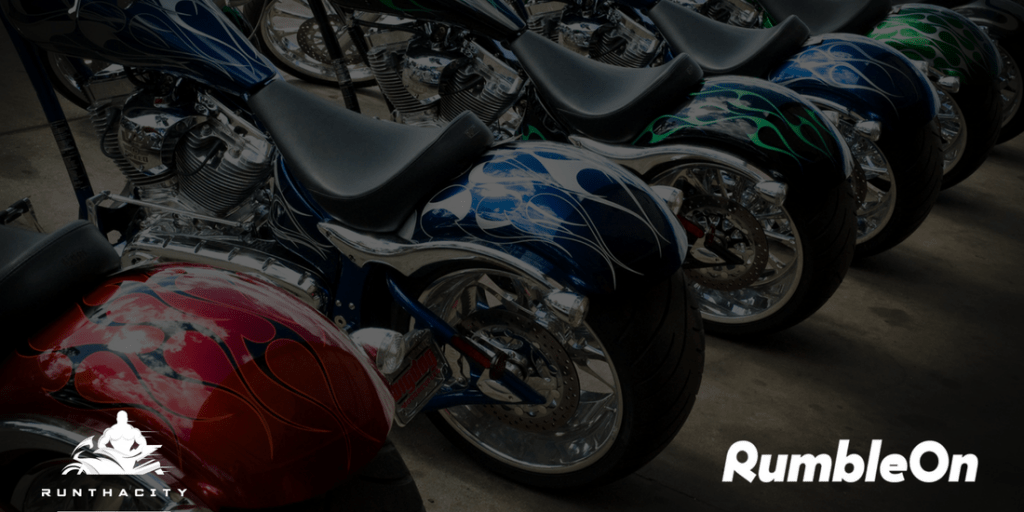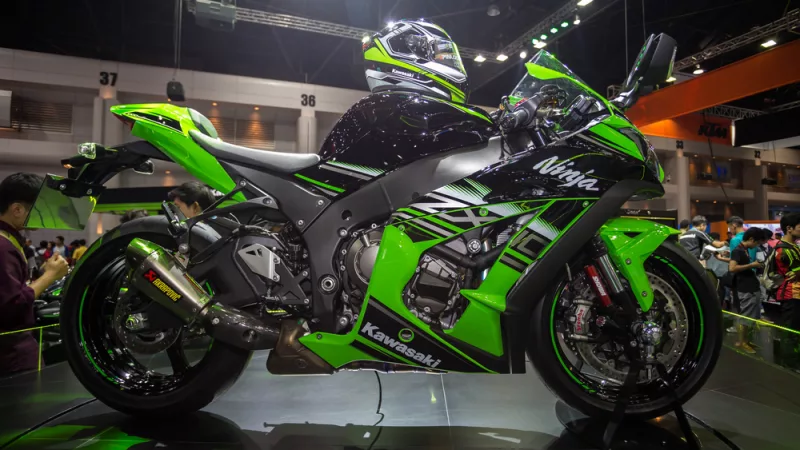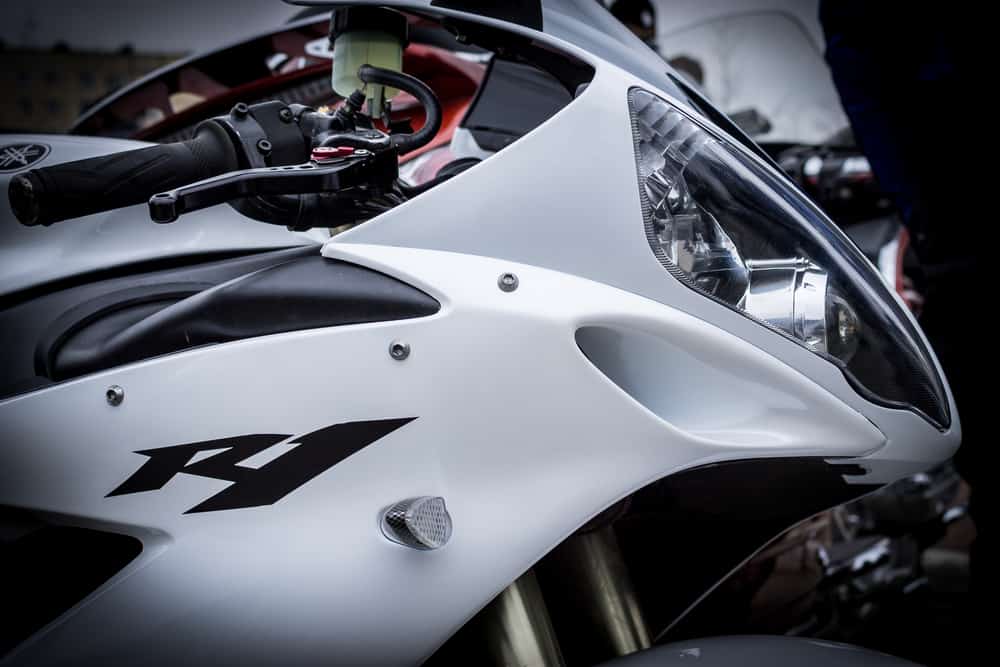There are multiple reasons that people want to replace the stock mufflers that came installed on their motorcycles and replace them with aftermarket exhausts. Whether your muffler has become worn or you simply want to upgrade to a better-performing exhaust, replacing it is something that is commonly done by motorcycle owners everywhere. Here is how you can install the Voodoo Slip-On Exhaust.
1. Read the instructions until you understand them
Before you get started, make sure that you read the instructions and that you understand them. You shouldn’t dive in until you are certain that you understand what you are doing. Then, gather together the tools that you will need to install your new exhaust.
2. Loosen the joint where it connects
The way in which your muffler is connected will depend on the motorcycle that you own. You may be looking for a gasketed flange joint or a band clamp. When you find the joint, loosen it so that you can get ready to remove your old muffler.
3. Loosen the bracket for the muffler
After you have loosened the connection joint, you will next need to loosen the brackets for your muffler. You will need to make certain that you provide support to the muffler while you are loosening its bracket. If you don’t, the muffler may strike other parts on your motorcycle and cause some damage.
4. Take the old muffler off of your motorcycle
While mufflers for motorcycles are called slip-ons, removing your old muffler may still require you to use some force to dislodge it from your bike. After you have taken the old muffler off, store it somewhere safe.
5. Take your new muffler and slide it over your header pipe
You will be doing the same steps that you just completed when you install your new muffler, but you will be doing them in reverse. If you find that you are having trouble, stop and think about what you are doing.
6. Securing your new muffler
You will secure your new Voodoo exhaust by attaching it with band-style clamps or with brackets. If you have band-style clamps, they will work by tightening around your muffler to hold it in place. Brackets attach to both your motorcycle and your muffler. Make certain that you familiarize yourself with the instructions before trying to secure your muffler. If you have brackets, try tightening them with your fingers first so that you are less likely to damage the parts. After everything is in its proper place, reattach the gasket clamps, flanges or springs that you need to attach the muffler to your head pipe. Make sure that you do not use too much torque.
7. Wipe your new exhaust down
Before you hop on your motorcycle, make sure that you wipe your new muffler down to remove the oils that you left behind during the installation. If you don’t, it may be stained when it runs with the oils on the surface.
8. Look for leaks
Turn on your motorcycle and let it run while you look at it for leaks. You should check the top of the headers and the base of your slip-on exhaust.
Legal issues
Make sure that you understand what the law in your area requires for modifications to your motorcycle’s exhaust. Some modifications are only allowed off of the highways in some states.
Installing your new Voodoo Slip-On Exhaust is a relatively straightforward process. If you make certain to read the manuals and that you understand the laws in your area, you can soon have a great-looking and sounding muffler on your bike.
You Might also like
-
21 Summer Motorcycle Rallies for Summer 2018
What’s better than the open road and a summer breeze on your face? At RumbleOn, we believe that it can only be beat by joining thousands of others who live and breathe for the same experience. This summer, don’t miss your chance to join a community of riders from across the nation by checking out this list of 25 events in 2018. Make lifelong connections, show off your ride, or even buy or sell a bike of your own!
Looking for more ways to adventure? We’ve also compiled the Best Biker Bars and Food Spots, Best Sights to See, and Best Roads to Ride for you.
July Events
Monday, July 9, 2018 – Thursday, July 12, 2018
Bowling Green, KY
32nd Annual Women on Wheels International Ride-In™
Tuesday, July 10, 2018 – Thursday, July 12, 2018
Johnson City, TN
Hell’s Canyon Motorcycle Rally
Thursday, July 12, 2018 – Monday, July 16, 2018
Baker City, OR
Monday, July 16, 2018 – Friday, July 20, 2018
Provo, UT
2018 Cascade Country Rendezvous and GS Rally by BestRest
Thursday, July 19, 2018 – Sunday, July 22, 2018
Republic, WA
ABATE of Indiana’s 38th Annual Boogie 2018
Thursday, July 19, 2018 – Sunday, July 22, 2018
Springville, IN
Thursday, July 19, 2018 – Sunday, July 22, 2018
Muskegon, MI
North Dakota Ladies Run – 31st Annual
Friday, July 20, 2018 – Sunday, July 22, 2018
Dickinson, ND
South East Raider Rally – 10th Annual
Sunday, July 22, 2018 – Sunday, July 29, 2018
Maggie Valley, NC
CMA Florida Summer Springs Fling
Friday, July 27, 2018 – Sunday, July 29, 2018
Ft. McCoy, FL
GWRRA Montana District Convention 2018
Thursday, July 26, 2018 – Saturday, July 28, 2018
Missoula, MT
Friday, July 27, 2018 – Sunday, July 29, 2018
Las Vegas, NM
August Events
Thursday, August 2, 2018 – Sunday, August 5, 2018
Black River Falls, WI
Friday, August 3, 2018 – Sunday, August 12, 2018
Sturgis, SD
Apple’s 15th Annual East Coast Motorcycle Rally
Wednesday, August 8, 2018 – Sunday, August 12, 2018
Little Orleans, MD
GWRRA Kentucky Blast District Convention 2018
Thursday, August 16, 2018 – Saturday, August 18, 2018
Cave City, KY
12th Annual Surfside Beach Bash
Friday, August 17, 2018 – Sunday, August 19, 2018
Oyster Creek, TX
Winding Road Ranch Biker Party 2018
Friday, August 24, 2018 – Sunday, August 26, 2018
Rush Springs, OK
Pennsylvania Rally on the River – Summer
Thursday, August 23, 2018 – Sunday, August 26, 2018
Northumberland, PA
September Events
Thunder in the Rockies Motorcycle Rally 2018
Friday, August 31, 2018 – Monday, September 3, 2018
Loveland, CO
Friday, August 31, 2018 – Monday, September 3, 2018
Pioneer, OH
-
The Ultimate List Of Motovloggers On YouTube Part II
Are you looking for motovloggers to follow?
Be sure to check out our other lists:
Shout Out To PhatboyR6 and No.Bumpers for helping me come up with this collection of motovloggers. So here they are in no particular order!
-
The Great Debate: Kawasaki Ninja vs. Yamaha R1
Sportbikes are some of the most popular and high-performance motorcycles on the road. With their sleek designs, powerful engines, and top-notch handling, they offer a thrilling and unique riding experience. Two of the most well-known sportbike models are the Kawasaki Ninja and the Yamaha R1. Both of these bikes are highly regarded in the sportbike community, but which one is the better choice? In this blog, we’ll take a closer look at the Kawasaki Ninja and Yamaha R1, and compare and contrast their features, performance, and overall value.
Kawasaki Ninja vs. Yamaha R1: Which Sportbike Reigns Supreme?
Kawasaki Ninja: A Closer Look The Kawasaki Ninja is a popular and well-regarded sportbike, known for its excellent handling and high-performance capabilities. With its lightweight frame and aerodynamic design, the Ninja provides quick acceleration and nimble handling. It also features a powerful engine, which delivers smooth and responsive power. Whether you’re commuting to work or hitting the back roads for a weekend ride, the Ninja is a great choice for any rider.
The Kawasaki Ninja and Yamaha R1 are two of the most popular and highly regarded sportbikes on the market. Both bikes offer a thrilling riding experience, with their powerful engines, top-notch handling, and sleek designs. But, which one is the better choice for riders? To answer this question, we’ll take a closer look at the key features, performance, and overall value of each bike.
Power and Performance: When it comes to power and performance, both the Kawasaki Ninja and Yamaha R1 deliver. The Ninja features a lightweight frame and aerodynamic design, which provide quick acceleration and nimble handling. The R1, on the other hand, boasts cutting-edge technology and advanced engineering, which provide exceptional power and handling capabilities. Ultimately, both bikes offer high-performance capabilities, but the Yamaha R1 may offer a more thrilling and intense riding experience for those who are looking for more power.
Features and Technology: The Yamaha R1 is known for its advanced electronics suite, which provides a range of features and functions to help riders get the most out of their bike. This includes traction control, power modes, and other advanced systems that can help riders customize their riding experience. The Kawasaki Ninja also offers some advanced technology, including a high-performance engine, but it may not be as feature-rich as the Yamaha R1.
Value for Money: Both the Kawasaki Ninja and Yamaha R1 are high-performance machines that offer excellent value for their price. However, there may be some differences in cost and features depending on the specific model you choose. When comparing the two, it’s important to consider the overall cost of ownership, including insurance, maintenance, and other expenses. The Kawasaki Ninja may offer better value for money for riders who are looking for a more budget-friendly option, while the Yamaha R1 may be a better choice for those who are willing to invest in a more advanced and feature-rich bike.
Thoughts:
The choice between the Kawasaki Ninja and Yamaha R1 comes down to personal preference and individual riding needs. Both bikes offer excellent performance, handling, and power, but there are some key differences in terms of features and value for money. If you’re looking for a budget-friendly option with good performance, the Kawasaki Ninja may be the better choice for you. But, if you’re looking for a more intense riding experience and advanced technology, the Yamaha R1 may be the way to go.
Kawasaki Ninja Model Overview
General Info
- Price: $18,199 USD / $20,899 CAD
- Key Features:
- Powerful 998cc In-line Four engine
- Lightweight chassis for superior handling
- Showa suspension and Brembo brake system
- IMU-enhanced electronics package
Key Specs
- Engine: 998cc, liquid-cooled, 4-stroke, DOHC 16-valve in-line four
- Power: 203 hp
- Torque: 82.5 lb-ft
- Dry Weight: 456 lb (207 kg)
- Seat Height: 32.9 in (835 mm)
Discover the Power and Performance of the Kawasaki Ninja
The Kawasaki Ninja is a well-known and highly regarded sportbike that offers a thrilling riding experience for riders of all levels. With its powerful engine, sleek design, and advanced technology, the Kawasaki Ninja has been a favorite among sportbike enthusiasts for many years. In this article, we’ll take a closer look at what makes the Kawasaki Ninja such a powerful and capable machine.
Engine and Power: The heart of the Kawasaki Ninja is its powerful engine, which provides exceptional acceleration and speed. Whether you’re commuting to work or tearing up the track, the Ninja’s engine delivers the power you need to get the job done. The Ninja features a lightweight frame and aerodynamic design, which work together to create a powerful and responsive machine that is both fast and nimble.
Handling and Suspension: The Kawasaki Ninja is known for its exceptional handling and suspension capabilities. The bike’s lightweight frame and advanced suspension system provide a smooth and stable ride, even at high speeds. Whether you’re carving through the turns or cruising down the highway, the Ninja delivers a comfortable and controlled ride that will keep you grinning from ear to ear.
Advanced Technology: The Kawasaki Ninja is also equipped with a range of advanced technology features that help riders get the most out of their bike. This includes traction control, power modes, and other advanced systems that allow riders to customize their riding experience. With these advanced technologies, riders can fine-tune their bike’s performance to match their riding style and preferences.
Design and Style: In addition to its powerful performance and advanced technology, the Kawasaki Ninja also stands out with its sleek and stylish design. The bike’s aerodynamic bodywork and aggressive lines give it a distinctive look that sets it apart from other sportbikes on the market. Whether you’re parked at the track or cruising down the street, the Kawasaki Ninja is sure to turn heads.
Thoughts:
The Kawasaki Ninja is a powerful and capable sportbike that offers riders a thrilling and enjoyable riding experience. With its powerful engine, exceptional handling, advanced technology, and stylish design, the Kawasaki Ninja is the ultimate choice for sportbike enthusiasts who demand the best. Whether you’re a seasoned rider or just starting out, the Kawasaki Ninja is sure to provide you with the power and performance you need to take your riding to the next level.
Experience the Cutting-Edge Technology and Thrilling Performance of the Yamaha R1
Comparing the Kawasaki Ninja and Yamaha R1 When it comes to comparing the Kawasaki Ninja and Yamaha R1, there are a number of factors to consider. Both bikes offer excellent performance, handling, and power, but there are some differences that set them apart. For example, the Yamaha R1 is known for its advanced electronics and cutting-edge technology, while the Kawasaki Ninja is known for its lighter weight and nimble handling. Ultimately, the choice between the two comes down to personal preference and individual riding needs.
The Yamaha R1 is a high-performance sportbike that offers riders a thrilling and unforgettable riding experience. With its cutting-edge technology, advanced engineering, and exceptional power and handling, the Yamaha R1 is one of the most sought-after sportbikes on the market. In this article, we’ll take a closer look at what makes the Yamaha R1 so special and what you can expect from this exceptional machine.
Performance and Power: The Yamaha R1 is designed to deliver high-performance and power, with its cutting-edge engineering and advanced technology. The bike features a powerful engine and lightweight frame, which work together to provide exceptional acceleration and speed. Whether you’re commuting to work or tearing up the track, the Yamaha R1 delivers the power and performance you need to get the job done.
Advanced Technology: One of the key features of the Yamaha R1 is its advanced electronics suite, which provides a range of features and functions to help riders get the most out of their bike. This includes traction control, power modes, and other advanced systems that allow riders to customize their riding experience. With these advanced technologies, riders can fine-tune their bike’s performance to match their riding style and preferences.
Handling and Suspension: In addition to its power and performance, the Yamaha R1 also offers exceptional handling and suspension capabilities. The bike’s advanced suspension system and lightweight frame provide a smooth and stable ride, even at high speeds. Whether you’re carving through the turns or cruising down the highway, the Yamaha R1 delivers a comfortable and controlled ride that will keep you grinning from ear to ear.
Design and Style: The Yamaha R1 is not only a high-performance machine, but it’s also a stylish and sleek sportbike that is sure to turn heads. The bike’s aerodynamic bodywork and aggressive lines give it a distinctive look that sets it apart from other sportbikes on the market. Whether you’re parked at the track or cruising down the street, the Yamaha R1 is sure to make a statement.
Thoughts:
The Yamaha R1 is a high-performance sportbike that offers riders a thrilling and unforgettable riding experience. With its cutting-edge technology, advanced engineering, and exceptional power and handling, the Yamaha R1 is the ultimate choice for sportbike enthusiasts who demand the best. Whether you’re a seasoned rider or just starting out, the Yamaha R1 is sure to provide you with the power, performance, and technology you need to take your riding to the next level.
Yamaha R1 Model Overview
General Info
- Price: $17,599 USD / $22,199 CAD
- Key Features:
- Yamaha Quickshift is standard
- Dynamic, adjustable suspension
- Advanced launch control system
Key Specs
- Engine Type: 998cc, liquid-cooled inline 4 cylinder DOHC; 16 valves
- Horsepower: 198 HP
- Torque: 83 lb-ft
- Wet Weight: 443 lbs (201 kg)
- Seat Height: 33.7 inches (855 mm)
Kawasaki Ninja vs. Yamaha R1: Comparing the Pros and Cons
Value for Money Another important factor to consider when choosing between the Kawasaki Ninja and Yamaha R1 is value for money. Both bikes are high-performance machines that offer excellent value for their price, but there may be some differences in cost and features depending on the specific model you choose. When comparing the two, it’s important to consider the overall cost of ownership, including insurance, maintenance, and other expenses.
When it comes to high-performance sportbikes, the Kawasaki Ninja and Yamaha R1 are two of the most popular and well-regarded models on the market. Both bikes offer exceptional power, handling, and technology, making it difficult to decide which one is right for you. In this article, we’ll take a closer look at the pros and cons of each bike to help you make an informed decision.
Kawasaki Ninja Pros:
- Power: The Kawasaki Ninja is known for its powerful engine and exceptional acceleration, making it a great choice for riders who demand high-performance and speed.
- Lightweight: The Ninja’s lightweight design makes it nimble and easy to handle, even at high speeds.
- Price: Compared to other high-performance sportbikes, the Kawasaki Ninja is often more affordable, making it a great choice for riders on a budget.
Kawasaki Ninja Cons:
- Vibration: Some riders have reported significant vibration from the Ninja’s engine, which can be uncomfortable for some riders.
- Brakes: While the Ninja’s braking system is capable, it may not provide the same level of stopping power as other high-performance sportbikes.
Yamaha R1 Pros:
- Technology: The Yamaha R1 features advanced electronics and technology that provide riders with a range of customization options and advanced features.
- Handling: The R1’s advanced suspension system and lightweight frame make it easy to handle and provide a smooth and stable ride, even at high speeds.
- Design: The Yamaha R1 has a distinctive, aggressive design that sets it apart from other sportbikes on the market.
Yamaha R1 Cons:
- Price: Compared to other sportbikes in its class, the Yamaha R1 is often more expensive, making it less accessible for some riders.
- Maintenance: The R1’s advanced technology and electronics may require more maintenance and upkeep than other sportbikes.
Thoughts:
The Kawasaki Ninja and Yamaha R1 are two of the best high-performance sportbikes on the market. Both bikes offer exceptional power, handling, and technology, making it difficult to decide which one is right for you. Ultimately, the choice between the two will come down to your personal preferences, riding style, and budget. Whether you choose the Kawasaki Ninja or the Yamaha R1, you can be sure that you’re getting a high-quality machine that will provide you with a thrilling and unforgettable riding experience.
Kawasaki Ninja vs. Yamaha R1: Which Sportbike Offers the Best Value for Money?
When it comes to high-performance sportbikes, the Kawasaki Ninja and Yamaha R1 are two of the most popular models on the market. Both bikes offer exceptional power, handling, and technology, but one key difference between them is their price. In this article, we’ll take a closer look at which bike offers the best value for money.
Kawasaki Ninja:
- Price: Compared to other high-performance sportbikes, the Kawasaki Ninja is often more affordable, making it a great choice for riders on a budget. This can also be seen as a pro for the Ninja when it comes to value for money.
- Performance: Despite its lower price, the Kawasaki Ninja still offers high-performance and speed, making it a great choice for riders who want a powerful bike without breaking the bank.
- Maintenance: The Ninja is relatively easy to maintain, which can help keep costs down over time.
Yamaha R1:
- Price: As one of the most advanced sportbikes on the market, the Yamaha R1 is often more expensive than other models in its class. This higher price tag may make it less accessible for some riders and less of a value for money option.
- Technology: The R1 features advanced electronics and technology that provide riders with a range of customization options and advanced features. However, this advanced technology also means that the R1 may require more maintenance and upkeep than other sportbikes.
- Performance: Despite its higher price, the Yamaha R1 offers exceptional power, handling, and technology, making it a great choice for riders who demand the best.
Thoughts:
Both the Kawasaki Ninja and Yamaha R1 offer high-performance and exceptional power, but when it comes to value for money, the Kawasaki Ninja is the clear winner. With its lower price and easier maintenance, the Ninja provides riders with a great combination of performance and affordability. However, if you’re looking for the latest technology and cutting-edge features, the Yamaha R1 may be the better choice for you, even if it does come at a higher cost. Ultimately, the choice between the two will come down to your personal preferences, riding style, and budget.
















